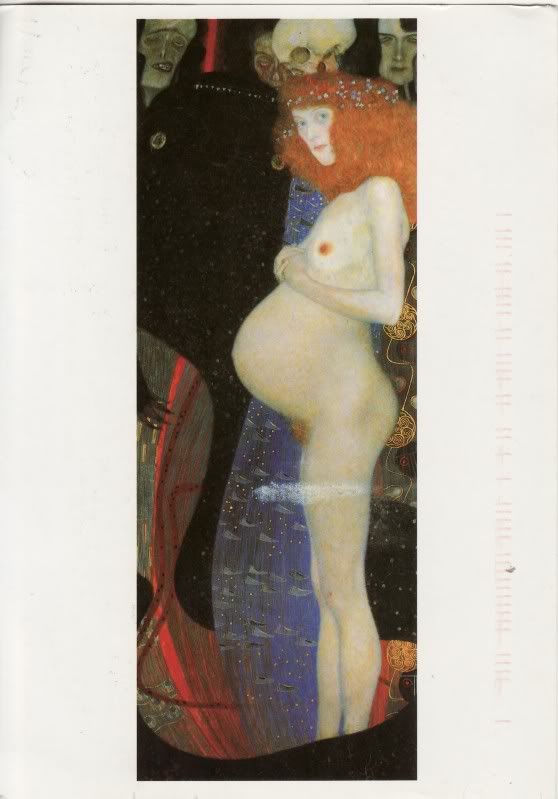Hope I (1903) by Gustav Klimt
 It is the return of the hero to his mother's womb, the end of his journey to a womb he should never have left, the last embrace, signifying also a return to the source, to the cosmos in which woman is the true conqueror. This "imprisonment in the womb" is to be found again in Hope I, in the magnificent belly that dominates everything like "a living vessel in which the hope of mankind is ripening". This intensely lyrical vision of the pregnant woman in Hope I is set in an ambiguous context peopled with masks, death's-heads, and allegorical monsters such as sin, disease, poverty and death, all threatening the incipient life. Assuredly the title of the picture and the shameless body are the epitome of perfect womanhood, a hymn to life and to the flesh. But are not the surrounding elements also images of night and death? Klimt invokes the full range of his erotic vocabulary, from the motifs of penetration in symbolic relation to the protruding belly, to the mildly perverse red hair, suggestive of Hans Baldung Grien. Nothing is there to remind us of the purity of Botticelli's Spring except the little garland of flowers in the hair. Once again, the painting was far too naturalistic and direct to be received by Klimt's contemporaries without causing a shock; inevitably they found it obscene. For a long time it remained in penitential obscurity in the private collection of Fritz Waerndorfer, where it was enclosed by two folding shutters like an altar, which emphasised its sacral character. Not until 1909 was the picture liberated, for an exhibition.
It is the return of the hero to his mother's womb, the end of his journey to a womb he should never have left, the last embrace, signifying also a return to the source, to the cosmos in which woman is the true conqueror. This "imprisonment in the womb" is to be found again in Hope I, in the magnificent belly that dominates everything like "a living vessel in which the hope of mankind is ripening". This intensely lyrical vision of the pregnant woman in Hope I is set in an ambiguous context peopled with masks, death's-heads, and allegorical monsters such as sin, disease, poverty and death, all threatening the incipient life. Assuredly the title of the picture and the shameless body are the epitome of perfect womanhood, a hymn to life and to the flesh. But are not the surrounding elements also images of night and death? Klimt invokes the full range of his erotic vocabulary, from the motifs of penetration in symbolic relation to the protruding belly, to the mildly perverse red hair, suggestive of Hans Baldung Grien. Nothing is there to remind us of the purity of Botticelli's Spring except the little garland of flowers in the hair. Once again, the painting was far too naturalistic and direct to be received by Klimt's contemporaries without causing a shock; inevitably they found it obscene. For a long time it remained in penitential obscurity in the private collection of Fritz Waerndorfer, where it was enclosed by two folding shutters like an altar, which emphasised its sacral character. Not until 1909 was the picture liberated, for an exhibition. Here is Klimt's erotic vocabulary in its totality, from shameless body, through perverse nuances of red head and red hair at the pubis, to the symbolic motifs of penetration resonating with the protruding belly. Around this picture of consummate femaleness appear elements of night and of death.
Here is Klimt's erotic vocabulary in its totality, from shameless body, through perverse nuances of red head and red hair at the pubis, to the symbolic motifs of penetration resonating with the protruding belly. Around this picture of consummate femaleness appear elements of night and of death. Information taken from here
No comments:
Post a Comment